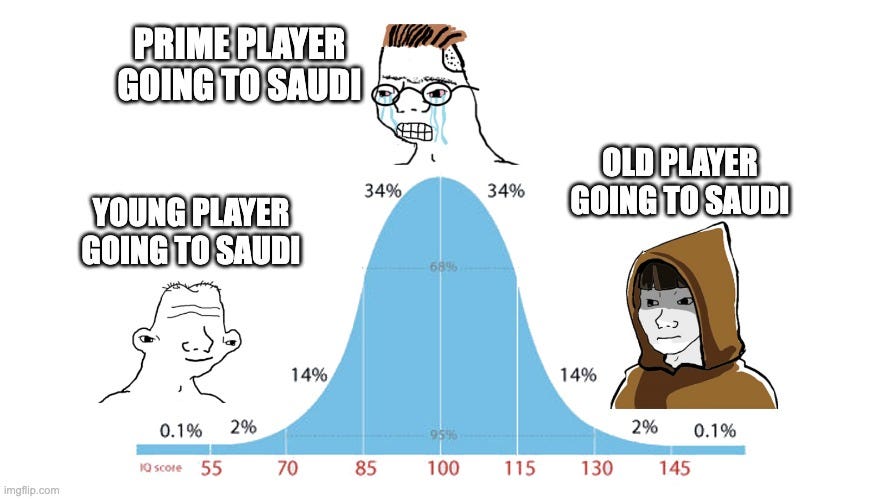How (and How Not) to Go to Saudi Arabia
The Midwit Meme Theory.
The Saudi Pro League is an old folks’ home, a competitor to Major League Soccer when it comes to attracting aging stars who can no longer cut it at the top level and are looking for one last big payday. Or at least, that’s how the story went when the Saudi Public Investment Fund took over four of the league’s teams in 2023 and started throwing insane money around, mostly at aging players.
But then, a major coup: Al-Ahli secured the services of Spanish midfield starlet Gabri Veiga in August of that year, and the 21-year-old was on his way to Jeddah rather than to Liverpool, Chelsea, Real Madrid, Manchester City, or Napoli — all of whom were reportedly interested.
Were the Saudis about to pay their way into genuine contention with Europe’s top leagues, snagging the best young talent and tilting the football world on its axis?
Not quite, and much of the reaction was something approaching the opposite: This kid is ruining his career. Midfield legend Toni Kroos called the move “embarrassing.” Any young player who wants to make it at the top level must play at the top level with top players who draw everything out of them in the heat of competition, from training to matchdays. Some believed Veiga’s decision was a sporting disgrace.
But what about the financial aspect?1 Kids dream of winning World Cups and Champions Leagues, but the time comes when they realize they have to set themselves up for life in the span of a relatively short playing career. They also have to provide for family and often many others in their lives.2 And while Gabri Veiga may or may not have dramatically improved as a player during his time in Saudi Arabia, he certainly accomplished that last bit. The reports are that he earned around €24 million in his two years in the Kingdom.
And now he’s going back to Europe at 23 years old, a move that some of us foresaw from the jump. It was never likely that young GV was going to be a career Saudi Pro League man. He made his money — and made €40 million for his boyhood club, Celta de Vigo, with the initial transfer fee — and now he’s back to compete in Portugal’s Primeira Liga and the Europa League3 with FC Porto.
He’ll reportedly take a “90% pay cut” to do so, but by my philosophy major calculations, he’s still making €1.2 million a year. Believe it or not, that’s more than I make from writing this newsletter.4 And more to the point, he’s still only 23. He could play well and earn a move to a truly top-level European outfit and earn bigger money through his prime years. Even if he hadn’t gone to Saudi, he might still be in this same position, playing for his big move. And if he plays eight or nine years of high-level stuff — a very real possibility — nobody will even remember his Saudi venture. This is, in short, how you do the Saudi thing.
How do you not do it? The way Theo Hernández is doing it.
The Frenchman was once the most terrifying marauding fullback in football, a dominant force down the left side as AC Milan stormed to a Serie A title just three years ago. Some Milan fans might tell you he’s fallen away from those heights, but he’s still only 27 years old. So why is he going to Al Hilal?
In an Instagram post, he questioned “the values” and “the ambition” of Milan’s current leadership, who reportedly balked at his significant wage demands, and plenty of Rossoneri fans might agree with his assessment. But is he demonstrating those qualities by spending his prime years in sporting obscurity? The money is good, but nobody watches the Saudi Pro League and nobody cares who wins it. The only player who breaks into the international headlines is Cristiano Ronaldo. Even Hernández’s compatriot, Karim Benzema, a Ballon d’Or winner three years ago, has fallen completely off the map since his move to Al-Ittihad apart from the occasional story peddling rumors that he wants to leave.
Maybe Hernández will pull a similar move to Gabri Veiga’s after two seasons — or after six months like Jhon Durán. But the likelihood is that the prime of the French fullback’s career will play out away from the pinnacle of the game he plays, unless his personal pinnacle has already passed. 26-year-old Argentine-Italian striker Mateo Retegui is also making the move from Serie A to Saudi this summer, and for him, too, this could be the functional end of his top-level sporting career. This is not even like going from world tours to a Vegas residency. These guys are going to Atlantic City while they could be world-touring, unless their decline is steeper and more inexorable than I’m aware of.
Assuming that’s not the case, they both seem like cautionary tales of how not to go to Saudi. It makes perfect sense for the old-timers to head out there for one more payday, just like they would going to New York or Miami or Los Angeles. (Though personally, I’d prefer the general ambiance of one of the latter.) And while I’d like to think I wouldn’t, it makes a certain kind of sense for very young players to go out there, get paid way more than they’re worth, then come back to Europe to follow their dreams at the top level. But going out to the desert for your prime years?
Maybe it’s the Midwit Meme theory of Saudi football: You want to be on one end or the other, not the middle.
Spanish paper Marca published a story claiming Veiga’s move was not about the money but the length of contract (three years, as opposed to the six Napoli offered) and the fact that European clubs were reluctant to pay his €40 million buyout clause. That last part is simply implausible. Forget the big clubs — it’s the kind of fee Wolverhampton Wanderers would pay for one of the biggest midfield prospects in Europe.
This is particularly common for top-level athletes, who disproportionately hail from modest circumstances. There’s a good argument that childhood poverty is the most formidable driver of athletic excellence.
Only the top two in Portugal qualify for the Champions League. My bad!



